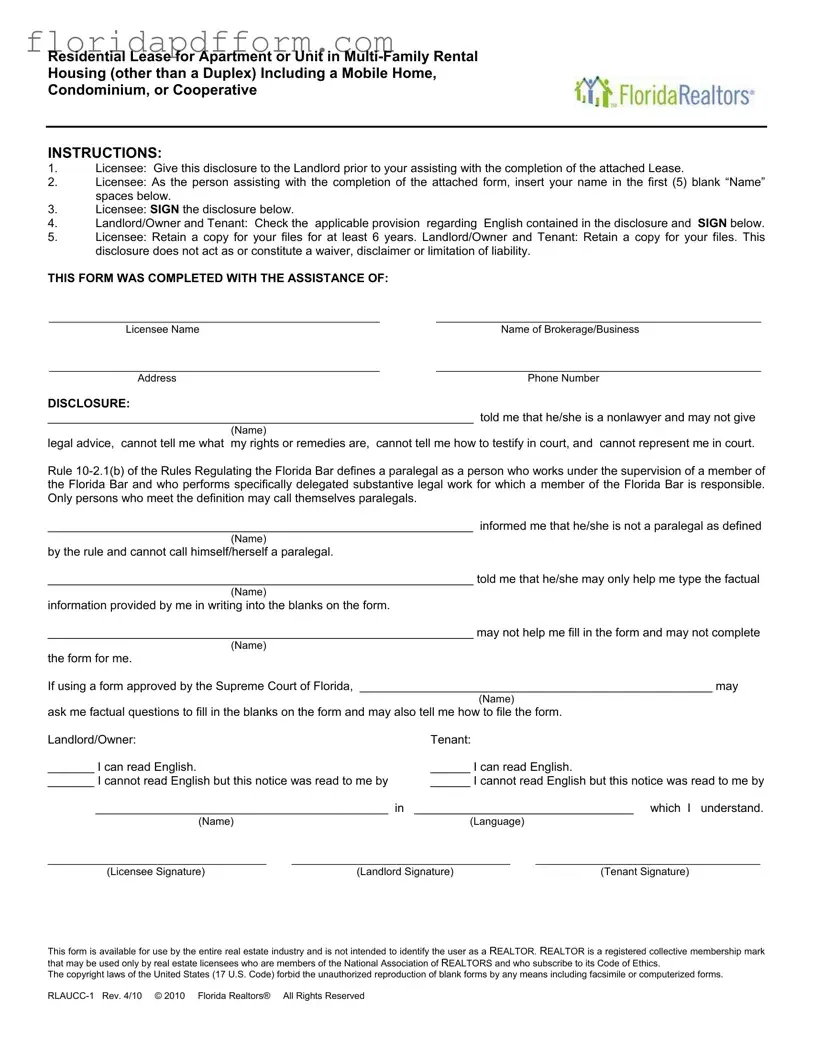-
What is the Florida Realtors Residential Lease form?
The Florida Realtors Residential Lease form is a standardized document used for renting residential properties in Florida. It is designed for multi-family rental housing, including apartments, mobile homes, condominiums, and cooperatives. This form outlines the terms of the lease agreement between the landlord and tenant, detailing responsibilities, rights, and obligations of both parties during the lease term.
-
What information is required to complete the form?
To complete the Florida Realtors Residential Lease form, both the landlord and tenant must provide essential information such as their names, contact details, and the address of the rental property. Additionally, the lease term, rental amount, and details about any security deposits or advance rent must be included. It is crucial to read the form carefully, as it contains specific provisions that require attention.
-
What should I do if I cannot read English?
If you cannot read English, the form provides options for you. You can have the lease read to you by someone who can translate it into your preferred language. The landlord or their agent must confirm that they have explained the contents of the lease to you. This ensures that you fully understand your rights and responsibilities under the lease agreement.
-
What happens if I need to terminate the lease early?
Should you need to terminate the lease before the end of the lease term, it is important to review the specific provisions related to early termination. If you are a member of the United States Armed Forces, you may have additional rights under Florida law that allow you to terminate the lease without penalty. Otherwise, early termination may require negotiation with the landlord and could involve penalties or loss of the security deposit.
-
What is a security deposit, and how is it handled?
A security deposit is a sum of money paid by the tenant to the landlord to cover potential damages or unpaid rent during the lease term. According to the Florida Realtors Residential Lease form, the landlord must hold the security deposit in a separate account and may be required to pay interest on it. At the end of the lease, the landlord must return the deposit, minus any deductions for damages or unpaid rent, within a specified time frame.
-
Can the landlord enter the premises without notice?
Generally, the landlord cannot enter the rental property without providing reasonable notice to the tenant, except in emergency situations. The lease specifies conditions under which the landlord or their agent can enter the premises, such as for repairs, inspections, or to show the property to prospective tenants. Tenants should be aware of their rights regarding privacy and notice requirements.
-
What are the responsibilities of the landlord and tenant regarding maintenance?
The lease outlines the maintenance responsibilities of both the landlord and tenant. The landlord is typically responsible for maintaining the structural integrity of the property and ensuring that it meets health and safety codes. Tenants are responsible for keeping the premises clean and in good condition. The lease may specify particular maintenance tasks assigned to either party, so it is essential to review this section carefully.
-
What should I do if I have a dispute with my landlord?
If a dispute arises between you and your landlord, it is advisable to first attempt to resolve the issue through direct communication. If that fails, you may refer to the Florida Residential Landlord and Tenant Act, which provides guidelines for handling disputes. This may include mediation or legal action, depending on the nature of the disagreement. Keeping a record of all communications and agreements can be beneficial.
-
Is it necessary to have a lawyer review the lease?
While it is not mandatory to have a lawyer review the lease, it is highly recommended, especially if you have questions or concerns about specific terms. A lawyer can provide valuable insights and ensure that your rights are protected. If you are unsure about any provisions, seeking legal advice can help clarify your obligations and rights under the lease.
